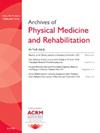Effects of Exercise Therapy in Axial Spondyloarthritis: A Systematic Review, Meta-analysis, and Meta-regression of Randomized Trials
IF 3.6
2区 医学
Q1 REHABILITATION
Archives of physical medicine and rehabilitation
Pub Date : 2025-01-01
DOI:10.1016/j.apmr.2024.06.005
引用次数: 0
Abstract
Objective
This study aimed to assess the effectiveness of exercise therapy for patients with axial spondyloarthritis (axSpA).
Data Sources
We searched MEDLINE (via PubMed), Cochrane Library, Embase, Web of Science, Scopus, and SPORTDiscus for all relevant publications from database inception to March 2024, without language restriction.
Study Selection
We included randomized controlled trials (RCTs) of patients with axSpA in which ≥1 group received exercise therapy.
Data Extraction
Two independent reviewers assessed the quality of the literature using the Cochrane Collaboration Risk of Bias Tool 2.0. The outcomes were ankylosing spondylitis (AS) disease activity score (ASDAS), Bath AS disease activity index (BASDAI), Bath AS functional index (BASFI), Bath AS metrology index (BASMI), 6-minute walk test (6MWT), chest expansion capacity, peak oxygen consumption (VO2peak), pain, fatigue, C-reactive protein (CRP), and erythrocyte sedimentation rate (ESR).
Data Synthesis
A total of 20 RCTs, including 1670 patients, were included in this study. Compared with the control group, exercise therapy improved BASFI (weighted mean difference [WMD], −0.49; 95% confidence interval [CI], −0.65 to −0.32; I2=3.4%; P=.414), BASMI (WMD, −0.49; 95% CI, −0.87 to −0.11; I2=71.9%; P=.679), BASDAI (WMD, −0.78; 95% CI, −1.08 to −0.47; I2=55.9%; P=.021), ASDAS (WMD, −0.44; 95% CI, −0.64 to −0.24; I2=0.0%; P=.424), VO2peak (WMD, 3.16; 95% CI, 1.37-4.94; I2=0.0%; P=.873), 6MWT (WMD, 27.64; 95% CI, 12.04-43.24; I2=0.0%, P=.922), pain (standardized mean difference [SMD], −0.47; 95% CI, −0.74 to −0.21; I2=66.0%, P=.046), and fatigue (SMD, −0.49; 95% CI, −0.71 to −0.27; I2=0.0%; P=.446). However, no significant benefit was found in chest expansion, CRP, and ESR outcomes.
Conclusions
Exercise therapy is an effective strategy for improving disease control and symptom relief in patients with axSpA.
运动疗法对轴向脊柱关节炎的影响:随机试验的系统回顾、荟萃分析和荟萃回归。
研究目的本研究旨在评估轴性脊柱关节炎(axSpA)患者运动疗法的有效性:从数据库建立之初到 2024 年 3 月,我们检索了 PubMed(通过 Medline)、Cochrane Library、Embase、Web of Science、Scopus 和 SPORTDiscus 的所有相关出版物,没有任何语言限制:我们纳入了针对axSpA患者的随机对照试验(RCT),其中至少有一组接受了运动疗法:两名独立审稿人使用 Cochrane 协作偏倚风险工具 2.0 评估了文献质量。研究结果包括强直性脊柱炎(AS)疾病活动度评分(ASDAS)、巴斯强直性脊柱炎疾病活动度指数(BASDAI)、巴斯强直性脊柱炎功能指数(BASFI)、巴斯强直性脊柱炎计量指数(BASMI)、6分钟步行距离(6MWT)、胸廓扩张能力、峰值耗氧量(VO2peak)、疼痛、疲劳、C反应蛋白(CRP)和血沉(ESR):本研究共纳入了 20 项 RCT,包括 1,670 名患者。与对照组相比,运动疗法改善了 BASFI(加权平均差 [WMD]:-0.49,95% 置信区间 [CI]:-0.65 至 -0.32,I2= 3.4%,P=0.414), BASMI (WMD: -0.49, 95% CI: -0.87 to -0.11, I2= 71.9%, P=0.679), BASDAI (WMD: -0.78, 95% CI: -1.08, -0.47, I2=55.9%, P=0.021), ASDAS (WMD: -0.44, 95% CI: -0.64至-0.24,I2=0.0%,P=0.424)、VO2peak(WMD:3.16,95% CI:1.37至4.94,I2=0.0%,P=0.873)、6MWT(WMD:27.64,95% CI:12.04至43.24,I2=0.0%,P=0.922)、疼痛(标准化平均差 [SMD]:-0.47,95% CI:-0.74 至 -0.21,I2= 66.0%,P=0.046)和疲劳(SMD:-0.49,95% CI:-0.71 至 -0.27,I2= 0.0%,P=0.446)。然而,在胸廓扩张、CRP和ESR结果方面没有发现明显的益处:运动疗法是改善axSpA患者疾病控制和症状缓解的有效策略。
本文章由计算机程序翻译,如有差异,请以英文原文为准。
求助全文
约1分钟内获得全文
求助全文
来源期刊
CiteScore
6.20
自引率
4.70%
发文量
495
审稿时长
38 days
期刊介绍:
The Archives of Physical Medicine and Rehabilitation publishes original, peer-reviewed research and clinical reports on important trends and developments in physical medicine and rehabilitation and related fields. This international journal brings researchers and clinicians authoritative information on the therapeutic utilization of physical, behavioral and pharmaceutical agents in providing comprehensive care for individuals with chronic illness and disabilities.
Archives began publication in 1920, publishes monthly, and is the official journal of the American Congress of Rehabilitation Medicine. Its papers are cited more often than any other rehabilitation journal.

 求助内容:
求助内容: 应助结果提醒方式:
应助结果提醒方式:


